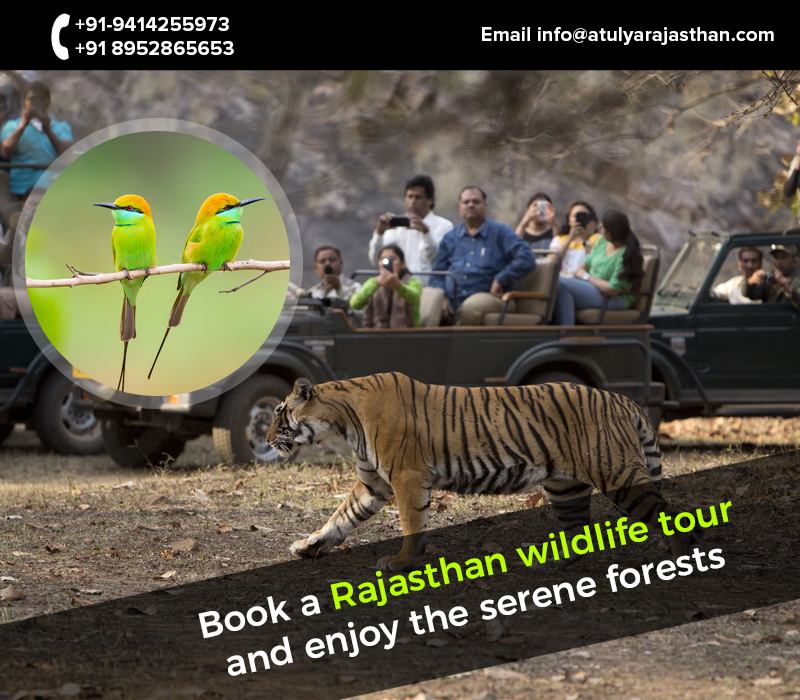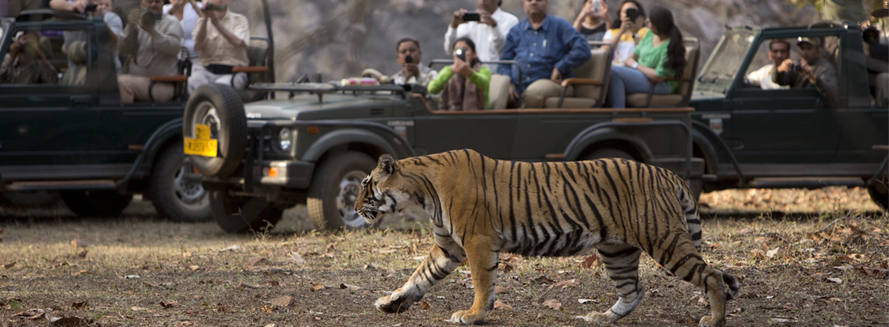
Still planning! An interaction with the nature awaits your advent. Peaceful journeys, jaunts and sojourns all can be experienced differently by integrating your trip with wildlife sightseeing.The beautiful animals, chirping birds and the natural scenic beauty all together make the trip alluring. All you need is to book a Rajasthan Wildlife Tour Package.
Well, imagining an encounter with a leopard will make you feel goose bumps but the excitement is worth the risk. Experiences at Rajasthan’s sanctuaries can be different, ranging from ‘humpy camel rides to bumpy gypsy-safari rides’. All of these enthralling experiences await your advent to the desert-state and can be experienced by a tour to Rajasthan.The moderate number of bird sanctuaries and national parks makes it a club for the ample species around world to stay here temporarily especially during winters. Hence, they have been under protection ever since from the humans wishing to settle. But, you can visit by booking a Rajasthan Wildlife tour package.
Some of the prime national parks and Bird sanctuaries of Rajasthan are:
• Keoladeo Ghana National Park
• Sariska Tiger Reserve
• Ranthambore National Park
• Kumbhalgarh Sanctuary
• Tal Chappar Wildlife sanctuary
• Mount Abu Sanctuary
• Darrah Sanctuary
• Machiya Safari park
• Desert National Sanctuary
These wildlife sanctuaries range from enclosed semi-green grasslands of Mount Abu and Darrah, kota to open and dry grasslands near Jaisalmer and Jodhpur, from the deciduous thorn forest in Alwar to the wetlands of Bharatpur. This vivid and varied geography makes these lands habitats to some animals and temporary place of stay for some migratory birds.
Ranthambore National Park:

Situated in SawaiMadhopur, Rajasthan, it is one of the largest and the most important National parks of India. This most popular sanctuary of Rajasthan was established under the name of SawaiMadhopur Game Sanctuary in the year 1955. Brought under the Project Tiger Scheme of 1973 and later declared a National Park in 1980, it is best known for the tiger populationthere. It was later merged in the adjacent sanctuaries and since then it is known as Ranthambore National Sanctuary.
The royal national animal, Tiger, can be best spotted during November and May as the lush green leaves present them amidst scenic beauty. Bound by Banas and Chambal, it is established on a plateau. The Ranthambore fort is also situated within the boundaries of the National park. It is abundant in Wildlife with species such as sloth bears, sambars, cheetals, hyenas, blue bulls (Nilgai), leopards, wild boars and tigers.
Primary attractions:
• Indian Tigers
• Get familiar with the wildlife on a jungle safari
• 500 species of flowering plants
• Finest resort in the middle of the wildlife
• Ample of species along with some endangered ones
Desert National Sanctuary:
The second largest in the country and one the most important national parks of Rajasthan, desert national park covers an area of 3162 square kms. Situated in the Thar Desert near Jaisalmer, it has an extraordinary landscape and thus, attracts tourists from all over the world.
Some of the total area that the covers, has sand dunes. Being a perfect example of the desert ecosystem, it constitutes of fix hilly dunes, salt lake bottom surfaces and rocks. Though it is a desert still it houses birdlife in abundance. The most common of them is the endangered great Indian Bustard along with kestrels, falcons, sand grouse, tawny eagles, vultures, harriers, laggar falcons and spotted eagles.
Here, at the desert national park animal fossils, more than 180 million years ago, have been recovered. To witness the outstanding collection of plant species you must visit this place during November and January. The animal species include hedgehogs, desert cats, black bucks, Bengal foxes, wolves and desert foxes.
Prime attractions of the desert national park:
• Great Indian Bustard, 1 meter tall bird, endangered species
• Black bucks and other beautiful species of deer
• Eye-catching Sam sand dunes
• GadsiSagar tank, the lake houses migratory birds during winters
• Jeep safaris
Sariska National Park:
One of the important National parks of Rajasthan; it was a hunting ground for the royal kingdom of Alwar until 1955 when it was declared a Wildlife reserve. It has been under the Project Tiger scheme since 1978 and has continued to shelter the Royal Bengal Tiger.
Scrub thorn and grass are the primary identity of this dry deciduous forest situated in Aravali hills. With an area of 866 square kms this reserve is 107 kms away from the capital city, Jaipur and 200 kms away from the Nation’s capital. Being a part of the Aravalis this reserve is rich in minerals such as copper.
Most of the tourists are attracted by the population of the Royal Bengal Tiger. It also houses species like monkeys, blue bulls (nilgai), langurs, four horned antelope (chausingha), golden jackals, chinkara, hares, jungle cats, wild boars, leopards and hyenas.
It is also home for various vivid bird species such as crested serpent eagle, tree pie, horned owl, golden backed woodpecker, peafowl, grey partridge and many others.
Kumbhalgarh Wildlife Sanctuary:
Situated in Rajsamand district of Rajasthan, it is one of the most famous sanctuaries of Rajasthan. Spreading in an area of 578 square kms, this sanctuary encircles the Kumbhalgarh fort. Elevated at 500 to 1200 meters, this sanctuary houses varied flora and fauna, some of which are endangered species.
The animal habitat includes black buck, four horned antelope, hares, wolves, sloth bears, leopards, blue bulls, jungle cats, sambhar and hyenas. This sanctuary also has birdlife in abundance that can be spotted easily. Jungle fowls(grey), doves, peacocks white breasted kingfisher, pigeons, bulbuls, parakeets and golden oriole are amongst the many species found in the sanctuary.
Only 100 kms away from Udaipur, the city of lakes, it is a popular tourist place. You can track on foot or can book a horse safari arranged by the locals of Kumbhalgarh.
Keoladeo Ghana National Park:
Formerly known as the Bharatpur bird Sanctuary, it is home to more than 200 migratory bird species. A large number of migratory birds visit this sanctuary at the time of hibernation that attracts large number of tourists as well from all across the globe. Many ornithologists also visit the park during this time.
It was declared as a protected zone in 1971 and a UNESCO world heritage site later. It is a human-made wetland that protects the town of Bharatpur from untimely floods and is also a grazing field for the village cattle. Earlier, it was known as the Hunting ground for the kingdom of Bharatpur.
A home for 380 plant species and more than 350 birds also constitutes of many animal species. It is one of the areas with most abundant aerial habitat. It came into existence around 200 years ago. It witnesses more than 1, 00,000 tourists every year out of which more than 40,000 are international visitors. Accommodations for the tourists are arranged in and near the sanctuary.
Highlights:
• Hunting ground for the kingdom of Bharatpur and is now a place for ornithologists to visit
• Bicycle and rickshaw safaris
• More than 350 vivid and exotic bird species
• One of the UNESCO world heritage sites in India
• Boat safaris
Darrah Sanctuary:
It was established during the year 2004 and is one of the most popular National parks in the state. It is a collection of three wildlife reserves that are the Darah wildlife sanctuary, Jaswantsagar wildlife sanctuary and Chambal wildlife sanctuary.
It is a large forest strip that was a hunting ground for the province of Kota. It covers an area of 250 square kms and is 50 km away from Kota. It has been declared a protected zone by the government of India since the year 1955. It houses animal species such as wolves, nilgais, boars and cheetah.
Darrah wildlife sanctuary is a very beautiful place and your interaction to this reserve’s beauty will leave you wonderstruck. The river Chandrabhaga flows near the National park. There are many temples that date back to the 7th and 8th century and are situated near the banks of the river. The park is closed for visitors from July to September due to the rainy season.
Mount Abu Sanctuary:
Declared as a wildlife sanctuary in the year 1980, it is one of the most visited sanctuaries in Rajasthan. It is recognized in the Aravali range. This sanctuary houses a moderate number of species of wild animals, birds, trees and plants.
It covers a 19 km long and 6 km wide area. It is elevated from 300 meters to approximately 1700 meters at the Guru Shikhar, the highest peak of Rajasthan. This place contains igneous rocks that have cavities formed in them due to the effects of wind and rain.
It is home to a large number of species of flora. It has around 100 plant families, more than 75 species of trees, 89 species that are only shrubs, more than 15 species of plants with swelled roots and approximately 30 species of the climbers.Varied orchid species are also found in this sanctuary along with a Bamboo forest in some parts.
Fauna, a large variety, includes Indian hares, porcupines, mangoose, bears, hedgehogs, tigers, jungle cats, leopards, lions, foxes, hyenas, lungurs, Indian civets, jackals and others. More than 200 species of birds are also found here, where the grey jungle fowl is the primary attraction.
Prime attractions:
• One of the oldest sanctuaries in the Aravalis
• Leopards, lions and tigers
• Grey Indian fowl
• More than one species of rose and other orchid plants
• Rock formations formed from wind and rain withering
• Trekking
Machiya Safari Park:
One of the most visited tiger reserves in Rajasthan. It is perfect exploration of the wildlife in Rajasthan. Machiya National park is situated approximately 1 km from the Kaylana Lake. It appears on the route from Jodhpur to Jaisalmer.
It is a must visit place for those who are intrigued by the wild. The primary animal species include the Monitor Lizards, wild cats, deer, mongoose, blue bull rabbits, desert fox and many more.
The best time to visit this sanctuary for tourists is from October to February. You may find Jeep safaris. While booking your Rajasthan tour packages make sure to include some of the above mentioned sanctuaries to get familiar with the nature and the wildlife in it.